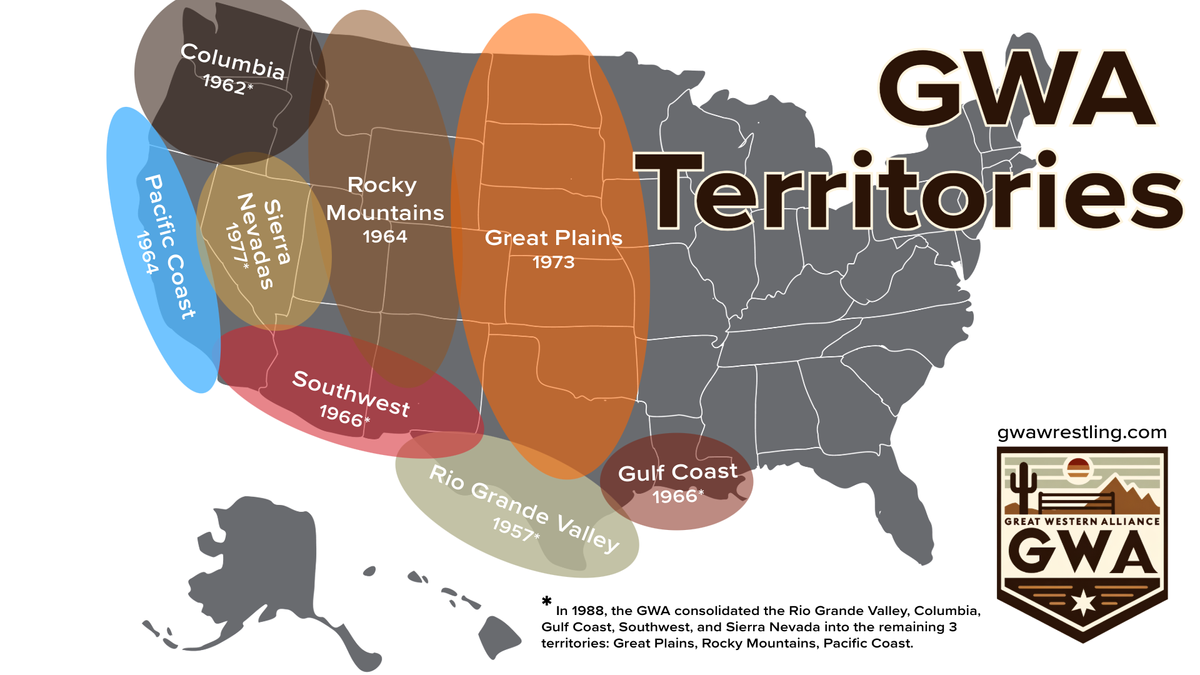GWA Territories
From the rugged coasts of the Pacific NW to the sunbaked plains of the Rio Grande Valley, the Great Western Wrestling Alliance built its legacy across diverse territories. These weren't just map regions—they were unique wrestling cultures with their own champions, styles, and passionate fan bases.

EXPLORE THE TERRITORIES
RIO GRANDE VALLEY (1959-1988)
HUB: San Antonio, TX
The Rio Grande Valley Territory encompasses the cultural crossroads of Texas and Northern Mexico, stretching from Austin to El Paso and south across the border to cities like Monterrey and Ciudad Juárez, creating a vibrant wrestling landscape that fuses American, Mexican, and Tejano influences. Known for its dynamic blend of lucha libre, Texas wrestling fundamentals, and border town brawling, this territory pioneered the GWA's cross-cultural appeal through bilingual programming and events that united communities on both sides of the border.
COLUMBIA (1962-1988)
HUB: Portland, OR
The Columbia Territory encompasses the Pacific Northwest, stretching from Seattle through Portland and into Vancouver, BC. This rugged territory combines the region's frontier spirit with technical wrestling excellence, featuring distinct seasonal touring patterns adapted to mountain passes and coastal routes. Known for its intense, ground-based style and strong connection to both American and Canadian wrestling traditions, the territory cultivates a unique blend of logging camp toughness and scientific wrestling precision.
PACIFIC COAST (1964-1993)
HUB: Los Angeles, CA
The Pacific Coast Territory represents the GWA's entertainment powerhouse, stretching from Los Angeles through San Francisco and up to Sacramento. This territory leverages Hollywood production values and California's entertainment infrastructure to create a uniquely polished wrestling product. The territory combines theatrical presentation with athletic competition, featuring a diverse roster that reflects the cultural melting pot of coastal California.
ROCKY MOUNTAIN (1964-1993)
HUB: Denver, CO
The Rocky Mountain Territory encompasses the challenging terrain of the American mountain west, centered in Denver and stretching across Colorado, Wyoming, Utah, and Montana. This unique territory adapts its operations to extreme weather conditions and mountain geography while celebrating the rugged spirit of frontier wrestling. The territory's success relies on careful seasonal planning, strategic routing between population centers, and a deep understanding of mountain community culture.
GULF COAST (1966-1988)
HUB: Houston, TX
A coastal wrestling territory operating along the Gulf of Mexico, centered in Houston and extending through coastal Texas and Louisiana. Known for its unique blend of Southern wrestling tradition, offshore oil culture, and port city dynamics.
SOUTHWEST (1966-1988)
HUB: Phoenix, AZ
The Phoenix-centered territory presents a unique operational landscape combining extreme desert conditions with rich cultural wrestling traditions spanning the U.S.-Mexico border. Operating across vast desert regions while maintaining strong lucha libre connections, the territory leverages growing urban populations alongside traditional mining communities.
FRONTIER (1968-1988)
HUB: Cheyenne, WY
Based in Cheyenne, this territory celebrates and preserves the spirit of the Old West, operating across cities and towns that maintain strong connections to their frontier heritage. The territory integrates wrestling events with rodeos, Western festivals, and historical sites to maintain its unique frontier character.
MEXICO (1968-1993)
HUB: Monterrey, ME
An administrative territory designation encompassing GWA's Mexican operations and championship defenses. Rather than a traditional geographic territory, it represents the GWA's presence in Mexico through existing venues and partnerships, primarily focused on championship matches featuring Mexican wrestlers.
CANADA (1968-1993)
HUB: Calgary, CA
An administrative designation for GWA's Canadian operations, focused on championship defenses and talent development. Functions through existing GWA venues and markets in Canada, particularly emphasizing technical wrestling excellence and Canadian wrestling traditions.
GREAT PLAINS (1973-1993)
HUB: Dallas, TX
Spanning from North Texas to the Canadian prairies, the Great Plains territory represents a vast wrestling landscape shaped by agricultural cycles, oil industry employment, and strong regional traditions. The territory's success depends on careful coordination with seasonal patterns, agricultural schedules, and vast distances between population centers.
SIERRA NEVADA (1977-1988)
HUB: Sacramento, CA
Centered around the Reno-Las Vegas gaming corridor, this territory uniquely integrates professional wrestling with Nevada's entertainment and casino culture. Operations adapt to both mountain geography and tourist flows, with distinct seasonal patterns and strong coordination with gaming properties.
TELEVISION (1975-1993)
HUB: Los Angeles, CA
A unique territory centered around GWA's television production hubs, leveraging the advanced broadcast capabilities and entertainment infrastructure of major Western cities. This territory focuses on creating compelling televised wrestling content across multiple time slots and formats, from daytime to late-night programming.
METRO (1985-1993)
HUB: Dallas, TX
Geared towards urban crowds, the Metro territory represents the modern alternative to the traditional Frontier territory, focusing on metropolitan audiences and contemporary wrestling styles.
"The territories weren't just places. They were living, breathing communities with their own stories to tell. When you wrestled in Portland, you weren't just in a different city than Houston—you were in a different world, with different rules and different expectations. That's what made the territory system special." —"Redwoods" Jack Carson
